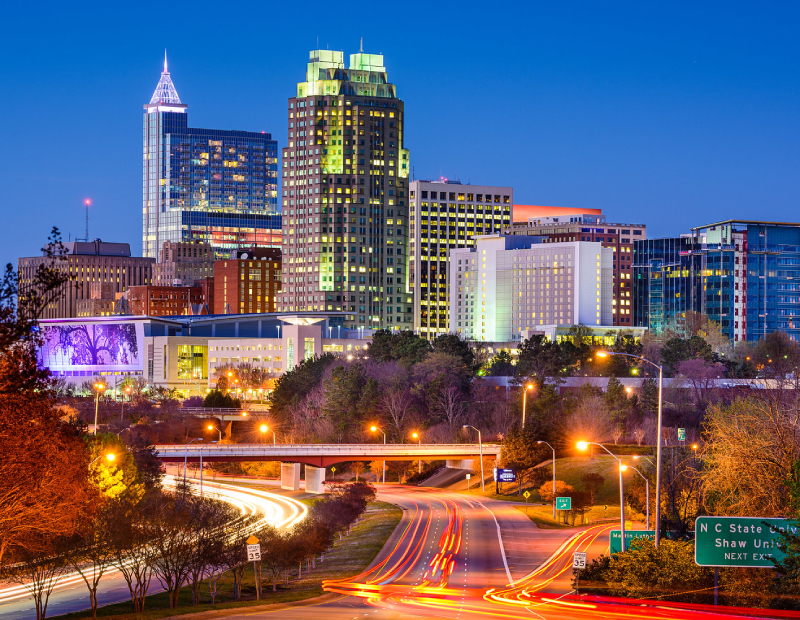5 Markets With the Greatest Vacancy Loss
Metro-level vacancy rates dropped by at least 170 basis points, more than four times the national average.
The national average vacancy rate decreased by 40 basis points in the 12 months ending in November, to 13.6 percent—the lowest level over the past year, according to Yardi Matrix data. While predominantly smaller metros with rather limited development activity were among the top markets for vacancy rate growth, the metros on this list account for more than 20 percent of the 156 million square feet of office space underway as of November. Thanks to high demand, their vacancy rate declined by as much as 250 basis points.
5. Raleigh-Durham, N.C.
Thanks to its favorable business climate and solid demographic gains, Raleigh-Durham’s office market continues to expand. The metro’s population rose by 18.5 percent since the 2010 Census, as of July 2018 estimates. This pushed up demand for both office employment and supply. The metro gained 24,200 positions in the 12 months ending in October—a quarter of those was office-using.
Meanwhile, developers were working on 2.6 million square feet in October, equal to 4.3 percent of existing inventory. Despite a rise in deliveries over the past three years, Raleigh-Durham’s vacancy decreased by 170 basis points in the 12 months ending in November, to 11.8 percent. While the sheer number of deals barely changed, sales volume decreased by 26 percent, as investors primarily targeted value-add opportunities. Transactions involving Class B and C assets accounted for three-quarters of the 52 deals closed in 2019 through November, almost double compared to the same interval in 2018. The metro’s big-dollar deals included Align Technology’s acquisition of a 198,500-square-foot office building in Morrisville, N.C.
4. Miami
Growth in Miami’s office sector shows no sign of losing steam, as the metro benefits from a diversifying economy and solid demographic growth as well as a tax-friendly business climate. Employers added 25,300 jobs in the 12 months ending in October when unemployment stood at 2.9 percent, 40 basis points below the national average. With 1.8 million square feet underway in October—representing 2.7 percent of the office stock—development is steady. Thanks to consistent leasing activity, the metro’s vacancy rate dropped 185 basis points in the 12 months ending in November, to 11.2 percent.
In Miami’s financial district, OKO Group and Cain International are working on 830 Brickell, which is expected to comprise some 500,000 square feet of office space. The company received a $300 million construction loan for the 57-story tower, slated for completion in the first quarter of 2022. At build-out, the project will be the submarket’s biggest office completion in almost a decade and the second-tallest office building in Miami.
3. Sacramento, Calif.
As the share of government jobs continues to diminish, the metro’s efforts to diversify its economy are paying off. Sacramento added 19,600 jobs in the 12 months ending in October, in spite of 2,100 government positions lost and thanks to the construction and education and health-care services sectors, which accounted for 80 percent of the jobs created.
A lower cost of construction and doing business compared to neighboring San Francisco and San Jose contributed to an uptick in construction activity in both the office and residential sectors. Some 900,000 square feet of office space was underway in October, equal to 1.6 percent of existing inventory. As deliveries have been rather limited over the past two years and demand for high-quality space was strong, Sacramento’s overall vacancy rate declined by 215 basis points in the 12 months ending in November when it stood at 12.7 percent.
Transaction activity almost exclusively concentrated on value-add acquisitions, accounting for 90 percent of the 42 deals closed year-to-date through November. However, total sales volume was up 21.8 percent from the same period in 2018, as a result of three big-dollar deals closed in the downtown. In the biggest transaction of 2019, Manulife Investment Management paid $198.8 million to Starwood Property Trust for the 500,000-square-foot Wells Fargo Center.
2. Manhattan
Of the three mainly office-using employment sectors, the only one to grow year-to-date through October in Manhattan was the professional and business services sector, which gained 13,400 positions. Meanwhile, the information and financial sector contracted by a total of 11,400 jobs during the same period. However, thanks to its overall strong and well-diversified economy, the metro’s job market added 57,700 jobs, amounting to 7.3 million.
With 19.6 million square feet of office space underway as of November, equal to 4.1 percent of existing inventory and the largest square footage under development in any single metro in the country, the office market’s expansion shows no sign of cooling. Strong demand kept up with the increased construction activity, and Manhattan’s average vacancy rate declined by 215 basis points in the 12 months ending in November, to 7.4 percent—the smallest for a primary office market.
Last December, Amazon signed a 335,400-square-foot lease in Manhattan for an upcoming office that will house more than 1,500 employees once it opens in 2021. In November, Facebook leased 1.5 million square feet across three buildings at Hudson Yards in one of the largest office leases ever signed in the borough. And earlier last year, Adobe renewed and expanded its lease at 1540 Broadway.
1. Austin
Thanks to outstanding population growth, consistent interest from tech firms and a business-friendly climate, office dynamics in Austin are as strong as ever. The metro added more than 10,000 office-using jobs in the 12 months ending in October, a 3.8 percent uptick.
The overall employment market grew by 27,800 positions, or 2.6 percent, surpassing 1.1 million jobs. As a result, development activity is booming, with 7.3 million square feet underway as of November, representing 10.5 percent of existing inventory. This placed Austin among the top markets for office construction. Robust tenant demand resulted in a 248 basis points decrease in the metro’s average vacancy rate in the 12 months ending in November when Austin had a vacancy rate of 8.2 percent.
Last November, Apple broke ground on its 33-acre campus in northern Austin, which is scheduled to come online in 2022. The 3 million-square-foot project is expected to accommodate as many as 5,000 employees once complete, with room to house up to 15,000 employees.











You must be logged in to post a comment.